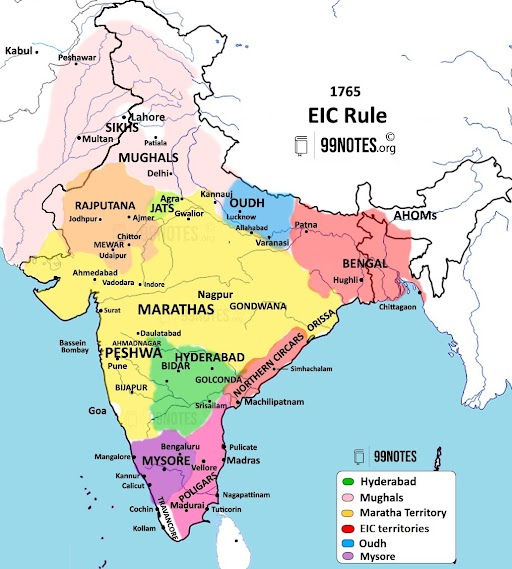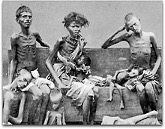



In 1756, young Siraj-ud-Daulah succeeded his grandfather as the Nawab of Bengal. He immediately identified that the British were misusing the Farukh Siyar’s farman to run even private trade tax-free. This led to a lot of leakage in revenue.
He took a series of steps that ensured that the conflict with the British was eminent.
Robert Clive was a British commander posted in Madras when the events in Bengal took place. In 1756, various diplomatic efforts were made from the British side, but Siraj did not respond. Thus, Clive’s forces of a couple of 1000 men were dispatched.
In early surprise attacks, the Nawab was intimidated. He tried to come to terms with Clive and surrender Calcutta, even promising to compensate the British for their losses. He also made a few unsuccessful attempts to secure an alliance with the French.
On the other hand, Clive allied with Mir Jafar (Siraj’s commander-in-chief), Jagat Seth (an influential banker of Bengal), Rai Durlabh, and Omichand against Siraj-ud-Daulah.
On the day of the battle, due to rain, Siraj’s cannons weren’t functioning; the betrayal of Mir Jafar’s and several of his key associates also dampened the morale. Thus, without much fight, Robert Clive’s technically superior forces defeated Siraj-ud-Daulah in the Battle of Plassey (June 23, 1757).
After the battle, Siraj was executed on Mir Jafar’s order.
As per the agreement between Mir Jafar and Clive, the battle resuted in three important developments:
The Battle of Plassey was the first step in building a British empire in India.
Mir Jafar’s rule as Nawab was not as smooth as he had thought. A British resident was placed in his court who interfered in his day to day affairs, and due to restriction-free trade the revenues were dwindling.
In such circumstances, he supported the Dutch in the battle of Hooghly/Chinsurah/Biderra (1759). But the English defeated the Dutch. Moreover, Mir Jafar failed to make the due payments to the Company.
Thus, company decided to replace Mir Jafar with someone more obedient.
After the death of Mir Jafar’s son Miran, Vansittart, the new Governor of Calcutta, supported Mir Kasim (the son-in-law of Mir Jafar) to become the Nawab of Bengal. Mir Jafar was ousted with a pension of Rs 1,500 per annum.
In 1760, Mir Kasim and the Company signed a treaty upon his appointment with the following terms:
Vary of British ways, after becoming Nawab, Mir Kasim immediately undertook two reforms:
Again, it was clear that the relation between the Nawab and the British wouldn’t be as smooth as the British had imagined.

Eventually, the growing differences led to the Battle of Buxar that officially gave the control over all of Bental to the British.
Due to these issues, there were battles between the Company and The Nawab in 1763. The English defeated Mir Kasim forces at Murshidabad, Katwah, Munger, Sooty, and Giria.
Mir Jafar was reinstalled with a monthly payment of ₹5,00,000/month to the British. This was against the policy of treating Kasim’s enemies as company’s enemies.
Being uneasy of the Company’s intentions, Mir Kasim escaped to Awadh (or Oudh) and formed a coalition with, Shuja-ud-Daulah (the Nawab of Awadh) and Shah Alam II (the Mughal Emperor).
The Battle : On October 22, 1764, the English forces under Major Hector Munro defeated the combined armies of Mir Kasim, Shuja-ud-Daulah and Shah Alam II in Buxar. In the battle, the British were aided by the likes of Zamindar Balwant Singh.
This had great significance as the English defeated the Nawab of Bengal and the Mughal Emperor of India. This victory essentially made the British the supreme power in northern India and contenders for supremacy over the whole country.
After the battle of Buxar, the British forced the Treaty of Allahabad on the parties involved.
The victory of English over Nawab of Bengal and the Mughal Emperor of India made the British the supreme power in northern India and contenders for supremacy over the whole country.
In August 1765, Robert Clive concluded two treaties at Allahabad –
Treaty of Allahabad With the Nawab of Awadh, Shuja-ud-Daula
Treaty of Allahabad With the Mughal Emperor, Shah Alam II
On September 30, 1765, another agreement was signed with the Nawab of the Bengal, Nazmuddaula, under which the Company agreed to pay the Nawab Rs. 53 lakhs annually to defray the costs of Nizamat (civil) administration and the Nawab’s household.
Treaty on Northern Circars: In 1765, Shah Alam also granted five ‘sarkars’, in the norther
circar region.

After obtaining the revenue rights, Robert Clive brought the dual system of government to Bengal. It means the rule of the two –
The Company’s rules –
The Nawab’s rule –
This system led to a peculiar situation:
This system of government was known as the Dual Government.
Initially the British continued with the revenue system that existed during the later Mughals. However, eventually they introduced a few reforms:
It laid the foundations of the British administration in India, and regulated the Company’s functions:
Eventually, Warrant hastings ended the Dual government.
The British continued the exploitative system of revenue administration that existed during the later Mughal
rule and made it more severe using the temporary settlement and the permanent settlement reforms

